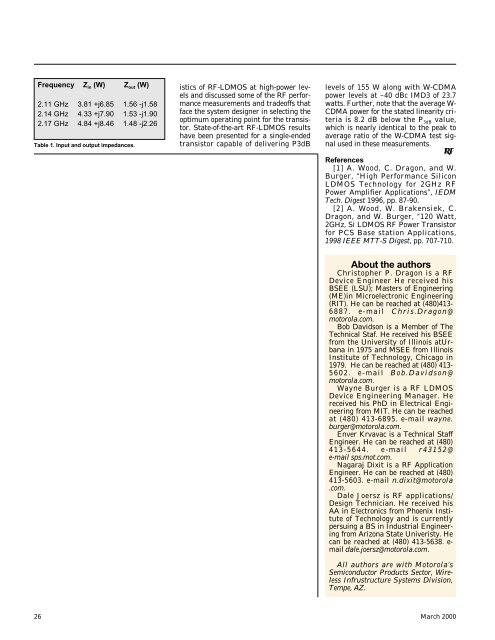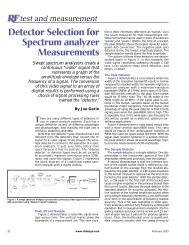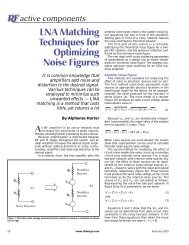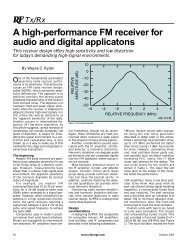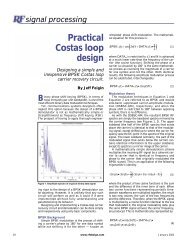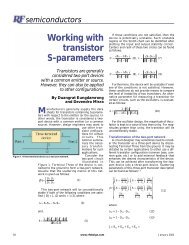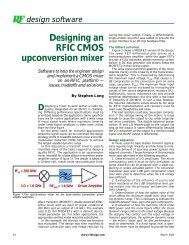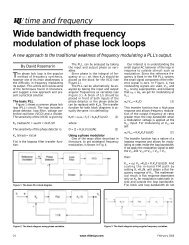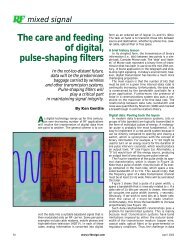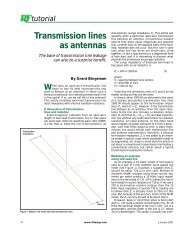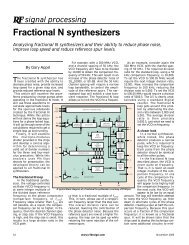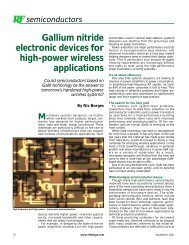High power RF-LDMOS transistors for base station applications
High power RF-LDMOS transistors for base station applications
High power RF-LDMOS transistors for base station applications
You also want an ePaper? Increase the reach of your titles
YUMPU automatically turns print PDFs into web optimized ePapers that Google loves.
Frequency Z in (W) Z out (W)<br />
2.11 GHz 3.81 +j6.85 1.56 -j1.58<br />
2.14 GHz 4.33 +j7.90 1.53 -j1.90<br />
2.17 GHz 4.84 +j8.46 1.48 -j2.26<br />
Table 1. Input and output impedances.<br />
istics of <strong>RF</strong>-<strong>LDMOS</strong> at high-<strong>power</strong> levels<br />
and discussed some of the <strong>RF</strong> per<strong>for</strong>mance<br />
measurements and tradeoffs that<br />
face the system designer in selecting the<br />
optimum operating point <strong>for</strong> the transistor.<br />
State-of-the-art <strong>RF</strong>-<strong>LDMOS</strong> results<br />
have been presented <strong>for</strong> a single-ended<br />
transistor capable of delivering P3dB<br />
levels of 155 W along with W-CDMA<br />
<strong>power</strong> levels at –40 dBc IMD3 of 23.7<br />
watts. Further, note that the average W-<br />
CDMA <strong>power</strong> <strong>for</strong> the stated linearity criteria<br />
is 8.2 dB below the P 3dB value,<br />
which is nearly identical to the peak to<br />
average ratio of the W-CDMA test signal<br />
used in these measurements.<br />
References<br />
[1] A. Wood, C. Dragon, and W.<br />
Burger, “<strong>High</strong> Per<strong>for</strong>mance Silicon<br />
<strong>LDMOS</strong> Technology <strong>for</strong> 2GHz <strong>RF</strong><br />
Power Amplifier Applications”, IEDM<br />
Tech. Digest 1996, pp. 87-90.<br />
[2] A. Wood, W. Brakensiek, C.<br />
Dragon, and W. Burger, “120 Watt,<br />
2GHz, Si <strong>LDMOS</strong> <strong>RF</strong> Power Transistor<br />
<strong>for</strong> PCS Base <strong>station</strong> Applications,<br />
1998 IEEE MTT-S Digest, pp. 707-710.<br />
About the authors<br />
Christopher P. Dragon is a <strong>RF</strong><br />
Device Engineer He received his<br />
BSEE (LSU); Masters of Engineering<br />
(ME)in Microelectronic Engineering<br />
(RIT). He can be reached at (480)413-<br />
6887. e-mail Chris.Dragon@<br />
motorola.com.<br />
Bob Davidson is a Member of The<br />
Technical Staf. He received his BSEE<br />
from the University of Illinois atUrbana<br />
in 1975 and MSEE from Illinois<br />
Institute of Technology, Chicago in<br />
1979. He can be reached at (480) 413-<br />
5602. e-mail Bob.Davidson@<br />
motorola.com.<br />
Wayne Burger is a <strong>RF</strong> <strong>LDMOS</strong><br />
Device Engineering Manager. He<br />
received his PhD in Electrical Engineering<br />
from MIT. He can be reached<br />
at (480) 413-6895. e-mail wayne.<br />
burger@motorola.com.<br />
Enver Krvavac is a Technical Staff<br />
Engineer. He can be reached at (480)<br />
413-5644. e-mail r43152@<br />
e-mail sps.mot.com.<br />
Nagaraj Dixit is a <strong>RF</strong> Application<br />
Engineer. He can be reached at (480)<br />
413-5603. e-mail n.dixit@motorola<br />
.com.<br />
Dale Joersz is <strong>RF</strong> <strong>applications</strong>/<br />
Design Technician. He received his<br />
AA in Electronics from Phoenix Institute<br />
of Technology and is currently<br />
persuing a BS in Industrial Engineering<br />
from Arizona State Univeristy. He<br />
can be reached at (480) 413-5638. e-<br />
mail dale.joersz@motorola.com.<br />
All authors are with Motorola’s<br />
Semiconductor Products Sector, Wireless<br />
Infrustructure Systems Division,<br />
Tempe, AZ.<br />
26 March 2000


